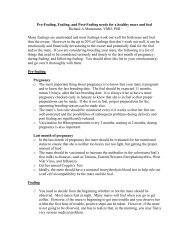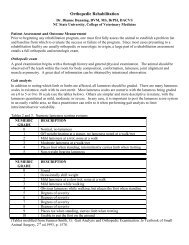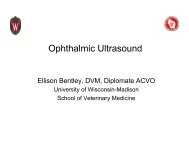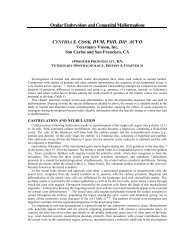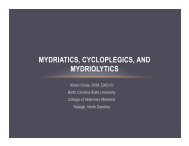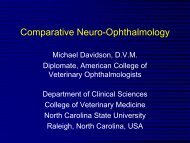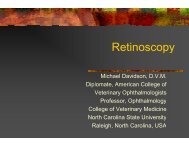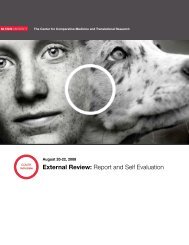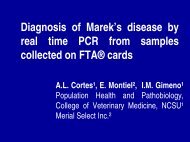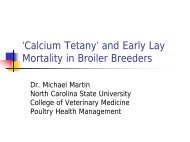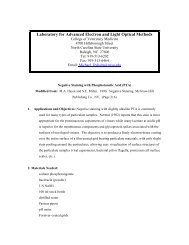LECTURE NOTES: Physiology of the Tear Film and Adnexa
LECTURE NOTES: Physiology of the Tear Film and Adnexa
LECTURE NOTES: Physiology of the Tear Film and Adnexa
Create successful ePaper yourself
Turn your PDF publications into a flip-book with our unique Google optimized e-Paper software.
<strong>LECTURE</strong> <strong>NOTES</strong>:<br />
<strong>Physiology</strong> <strong>of</strong> <strong>the</strong> <strong>Tear</strong> <strong>Film</strong><br />
<strong>and</strong> <strong>Adnexa</strong><br />
2012 William Magrane Basic Science Course<br />
in Veterinary & Comparative Ophthalmology<br />
Elizabeth A. Giuliano Giuliano, , DVM, MS<br />
Diplomate, ACVO<br />
University <strong>of</strong> Missouri<br />
“Lacrimal Functional Unit (L.F.U.)”<br />
A complex functional unit which modulates <strong>the</strong><br />
homeostasis <strong>of</strong> <strong>the</strong> ocular surface<br />
Lacrimal Lacrimal gl<strong>and</strong><br />
gl<strong>and</strong><br />
<strong>Tear</strong> film<br />
Ocular surface epi<strong>the</strong>lium<br />
Cornea, conjunctiva, meibomian gl<strong>and</strong>s<br />
Eyelids<br />
Interconnecting sensory <strong>and</strong> motor nerves<br />
1
“Lacrimal Functional Unit (L.F.U.)”<br />
Stern, Gao Gao, , Siemasko et al Experimental Eye Research, 2004<br />
Control <strong>of</strong> <strong>Tear</strong> Secretion – New Concepts<br />
Traditional<br />
Normal tears: <strong>the</strong> result <strong>of</strong> intrinsic lacrimal gl<strong>and</strong> activity;<br />
neural participation in reflex tears only<br />
New concept: tears under constant neural regulation<br />
On On-going going homeostatic regulation <strong>of</strong> <strong>the</strong> ocular surface<br />
Suggests a relatively constant level <strong>of</strong> neural signals that<br />
precisely meter tear production; may mediate lipid & mucin<br />
secretion also<br />
Control mechanism mechanism includes includes afferent nerves nerves from from <strong>the</strong> <strong>the</strong> cornea cornea <strong>and</strong><br />
<strong>and</strong><br />
o<strong>the</strong>r ocular surface tissues central central nervous system relay nuclei<br />
efferent nerves comprise <strong>the</strong> autonomic innervation to<br />
secretory tissues whose products contribute to <strong>the</strong> tear film<br />
2
Lacrimal Gl<strong>and</strong> Innervation:<br />
Afferent Pathway <strong>of</strong> Trigeminal Ganglion Ganglion-Mediated Mediated Reflex<br />
Irritation <strong>of</strong> cornea/conjunctiva stimulates afferent nerves:<br />
Impulses are carried along lacrimal nerve nerve <strong>the</strong><br />
<strong>the</strong><br />
ophthalmic division <strong>of</strong> <strong>the</strong> trigeminal nerve sensory<br />
nuclei in trigeminal ganglion (TG)<br />
Lacrimal nerve is <strong>the</strong> smallest branch <strong>of</strong> <strong>the</strong> ophthalmic nerve. It<br />
courses laterally within <strong>the</strong> orbital cavity above <strong>and</strong> along <strong>the</strong><br />
upper border <strong>of</strong> <strong>the</strong> lateral rectus muscle<br />
TG is connected to lacrimal nucleus <strong>of</strong> facial nerve in pons<br />
by internuncial neurons<br />
Impulses are directed, by way <strong>of</strong> <strong>the</strong> trigeminal ganglion,<br />
to <strong>the</strong> lacrimal nucleus<br />
Lacrimal Gl<strong>and</strong> Innervation:<br />
Afferent Pathway <strong>of</strong> Trigeminal Ganglion Ganglion-<br />
Mediated Reflex<br />
Cornea<br />
conjunctiva j i Lacrimal nerve<br />
stimulus<br />
Lacrimal gl<strong>and</strong><br />
Slide courtesy <strong>of</strong> Dr. Ota<br />
Ophthalmic nerve<br />
Maxillary nerve<br />
M<strong>and</strong>ibular nerve<br />
Trigeminal<br />
ganglion<br />
Pons<br />
Lacrimal nucleus<br />
<strong>of</strong> <strong>the</strong> facial nerve<br />
in <strong>the</strong> pons<br />
3
Lacrimal Gl<strong>and</strong><br />
Additional Sensory Innervation<br />
The afferent innervation <strong>of</strong> <strong>the</strong> lacrimal gl<strong>and</strong> is also<br />
provided by <strong>the</strong> ipsilateral superior vagal ganglion<br />
(SVG) <strong>and</strong> superior glossopharyngeal ganglion<br />
(SGG)<br />
There may be SVG <strong>and</strong> SGG-mediated reflexes in<br />
addition to <strong>the</strong> TG-mediated reflex<br />
S.B Cheng et al. Three novel neural pathways to <strong>the</strong><br />
lacrimal gl<strong>and</strong>s <strong>of</strong> <strong>the</strong> cat. Brain Research 873 (2000)<br />
In humans, <strong>the</strong>re is a connection between<br />
hypothalamus <strong>and</strong> lacrimal nucleus ( (emotional emotional<br />
tears), <strong>and</strong> between olfactory system <strong>and</strong> lacrimal<br />
nucleus (“ (“wasabe wasabe tears”)<br />
Lacrimal Gl<strong>and</strong> – Innervation<br />
Recommend Gia Klauss’s chapter on “non-hypotensive<br />
“non hypotensive autonomic agents in<br />
veterinary ophthalmology” VCNA, Ocular <strong>the</strong>rapeutics, 2004<br />
Autonomic innervation - sympa<strong>the</strong>tic sympa<strong>the</strong>tic:<br />
Th The sympa<strong>the</strong>tic th ti postganglionic t li i fibers fib arise i from f <strong>the</strong> th cranial i l<br />
cervical sympa<strong>the</strong>tic ganglion which is <strong>the</strong> uppermost ganglion <strong>of</strong><br />
<strong>the</strong> sympa<strong>the</strong>tic trunk <strong>and</strong> travel in <strong>the</strong> plexus <strong>of</strong> nerves around <strong>the</strong><br />
internal carotid artery<br />
They join <strong>the</strong> maxillary nerve, <strong>the</strong> zygomatic nerve, <strong>the</strong><br />
zygomaticotemporal nerve <strong>and</strong> finally <strong>the</strong> lacrimal nerve (a branch<br />
<strong>of</strong> <strong>of</strong> <strong>of</strong> <strong>the</strong> <strong>the</strong> ophthalmic ophthalmic nerve) ner e)<br />
Distributed to interstitium surrounding acini <strong>and</strong> to vascular smooth<br />
muscle fibers <strong>of</strong> gl<strong>and</strong>s<br />
Sympa<strong>the</strong>tic nerves contain norepinephrine <strong>and</strong> neuropeptide Y (NPY)<br />
Sympa<strong>the</strong>tic stimulation increases tear secretion by affecting vascular<br />
supply to lacrimal gl<strong>and</strong> as well as activating a G protein pathway<br />
4
Slide courtesy <strong>of</strong> Dr. Ota<br />
Lacrimal gl<strong>and</strong><br />
vascular smooth<br />
muscle<br />
Acinar cells,<br />
ductules <strong>and</strong><br />
tubules<br />
↑ protein secretion<br />
↑ blood flow<br />
Sympa<strong>the</strong>tic innervation<br />
Lacrimal nerve<br />
Zygomatic<br />
nerve<br />
Plexus <strong>of</strong> nerves<br />
around <strong>the</strong> internal<br />
carotid artery<br />
Cranial cervical<br />
sympa<strong>the</strong>tic ganglion<br />
Ophthalmic nerve<br />
Maxillary nerve<br />
In some species, <strong>the</strong> sympa<strong>the</strong>tic nervous system may influence tear secretion,<br />
not only by modulating blood flow to <strong>the</strong> gl<strong>and</strong> <strong>and</strong> its distribution within it,<br />
but also by direct effects on <strong>the</strong> secretory acini.<br />
Lacrimal Gl<strong>and</strong> – Innervation<br />
Autonomic innervation - parasympa<strong>the</strong>tic<br />
Parasympa<strong>the</strong>tic secromotor nerve supply to lacrimal gl<strong>and</strong> is<br />
derived from <strong>the</strong> lacrimal nucleus <strong>of</strong> <strong>the</strong> facial nerve<br />
The pre pre-ganglionic ganglionic fibers reach <strong>the</strong> pterygopalatine<br />
(sphenopalatine<br />
sphenopalatine) ) ganglion via <strong>the</strong> great petrosal nerve <strong>and</strong> vidian<br />
nerves as <strong>the</strong>y pass through <strong>the</strong> pterygoid canal<br />
The efferent postganglionic parasympa<strong>the</strong>tic impulses are <strong>the</strong>n<br />
transmitted via sphenopalatine nerve in <strong>the</strong> zygomatic nerve (a<br />
branch <strong>of</strong> <strong>the</strong> maxillary division <strong>of</strong> <strong>the</strong> trigeminal nerve). They <strong>the</strong>n<br />
pass into zygomatic temporal nerve which reaches <strong>the</strong> lacrimal<br />
gl<strong>and</strong><br />
The zygomatic temporal nerve also gives <strong>of</strong>f a recurrent branch to <strong>the</strong><br />
lacrimal nerve, from which <strong>the</strong> efferent fibers terminate in <strong>the</strong> lacrimal gl<strong>and</strong><br />
T1<br />
5
Lacrimal Gl<strong>and</strong> – Innervation<br />
Autonomic innervation – parasympa<strong>the</strong>tic<br />
Postganglionic parasympa<strong>the</strong>tic fibers innervate:<br />
Acinar cells, duct cells, <strong>and</strong> blood vessels<br />
Exerts principal neural control <strong>of</strong> electrolyte, water <strong>and</strong><br />
protein secretion<br />
Stimulatory effect mediated mediated via via acetylcholine acetylcholine <strong>and</strong><br />
<strong>and</strong><br />
vasoactive intestinal peptide (VIP)<br />
Increase Increase in tear secretion through a G protein pathway<br />
<strong>and</strong> perhaps a calcium/ calcium/calmodulin calmodulin pathway<br />
Lacrimal Gl<strong>and</strong> – Innervation<br />
Autonomic innervation – parasympa<strong>the</strong>tic<br />
Lacrimal gl<strong>and</strong> secretion inhibited by Leu-Enkephaline<br />
Leu Enkephaline<br />
(L-Enk (L (L Enk Enk) Enk)<br />
A neuropeptide that interacts with inhibitory G proteins<br />
Interferes with activation adenylate cyclase by G stimulatory<br />
proteins<br />
Postganglionic parasympa<strong>the</strong>tic fibers also innervate <strong>the</strong><br />
nasal gl<strong>and</strong>s gl<strong>and</strong>s via via <strong>the</strong> caudal nasal nasal nerve nerve (from (from <strong>the</strong><br />
<strong>the</strong><br />
maxillary nerve <strong>of</strong> <strong>the</strong> trigeminal nerve)<br />
6
Parasympa<strong>the</strong>tic innervation<br />
Lacrimal gl<strong>and</strong><br />
acinar cells, tubules<br />
ductules <strong>and</strong><br />
vascular wall<br />
Lacrimal nerve<br />
Zygomatico<br />
temporal<br />
nerve<br />
Zygomatic<br />
nerve<br />
Ophthalmic nerve<br />
Maxillary nerve<br />
M<strong>and</strong>ibular nerve<br />
Electrolyte <strong>and</strong><br />
water secretion Pterygoid canal<br />
Slide courtesy <strong>of</strong> Dr. Ota<br />
Sphenopalatine<br />
nerve<br />
Pterygopalatine<br />
(Sphenopalatine)<br />
ganglion<br />
Post-ganglionic parasympa<strong>the</strong>tic fibers<br />
Vidian n.<br />
Trigeminal<br />
ganglion<br />
Pons<br />
Greater petrosal n.<br />
Lacrimal nucleus<br />
CN VII<br />
Pre-ganglionic parasympa<strong>the</strong>tic fibers<br />
Parasympa<strong>the</strong>tic innervation<br />
More than one parasympa<strong>the</strong>tic ganglion is<br />
involved in <strong>the</strong> neural regulation <strong>of</strong> lacrimal gl<strong>and</strong><br />
secretion.<br />
Ciliary ganglion (CG)<br />
Otic ganglion (OG)<br />
J. Anat. 199 (1996), Brain Res 873 (2000)<br />
Some anatomical studies suggest that small<br />
neurons mediate <strong>the</strong> vasodilation <strong>of</strong> <strong>the</strong> lacrimal<br />
gl<strong>and</strong>, while <strong>the</strong> large neurons mediate <strong>the</strong><br />
lacrimal secretion<br />
Brain Res 873(2000), Brain Res 522 (1990)<br />
7
Additional References<br />
Lacrimal Gl<strong>and</strong> Innervation<br />
Ding C, Walcott B, Keyser KT. Sympa<strong>the</strong>tic neural control <strong>of</strong> <strong>the</strong><br />
mouse lacrimal gl<strong>and</strong>. Invest Ophthalmol vis Sci. 2003; 44: 1513-<br />
1520<br />
Cheng S, Kuchiiwa S, Kuchiiwa T et al. Three novel pathways to <strong>the</strong><br />
lacrimal gl<strong>and</strong>s <strong>of</strong> <strong>the</strong> cat: an investigation with cholera toxin B<br />
subunit as a retrograde tracer. Brain Res. 2003; 873:160-164<br />
Powell CC, Martin CL. Distribution <strong>of</strong> cholinergic <strong>and</strong> adrenergic<br />
nerve fibers in <strong>the</strong> lacrimal gl<strong>and</strong>s <strong>of</strong> dogs. Am JVet Res 1989; 50:<br />
2084-2088<br />
Text Books<br />
Milder B. The lacrimal system<br />
Snell RS, Lemp MA. Clinical Anatomy <strong>of</strong> <strong>the</strong> eye<br />
Kaufman PL, Alm A. Adler’s <strong>Physiology</strong> <strong>of</strong> <strong>the</strong> eye<br />
Krachmer JH, Mannis MJ, Holl<strong>and</strong> EJ. Cornea<br />
“Veterinary Neurology” by Oliver, Hoerlein, <strong>and</strong> Mayhew<br />
8
“Lacrimal Functional Unit (L.F.U.)”<br />
Normal tears essential:<br />
1. To prevent surface infection<br />
2. Provide a pure p optical p surface for light g refraction<br />
3. Maintenance <strong>of</strong> surface “homeostatic”<br />
environment<br />
Concept <strong>of</strong> L.F.U. – first introduced by Stern<br />
et al Cornea, 1998<br />
D Describe ib th <strong>the</strong> relationship l ti hi between b t ocular l surface f<br />
<strong>and</strong> <strong>the</strong> lacrimal gl<strong>and</strong>s in normal tear secretion<br />
<strong>and</strong> during inflammation<br />
Composed <strong>of</strong> tear film, ocular surface epi<strong>the</strong>lium,<br />
eyelids, interconnecting sensory <strong>and</strong> motor nerves<br />
9
Lipid<br />
<strong>Tear</strong> <strong>Film</strong> – Anatomy & <strong>Physiology</strong><br />
<strong>the</strong> “traditional” teaching<br />
Most superficial layer<br />
Stabilize & prevent evaporation <strong>of</strong><br />
aqueous layer<br />
Produced by <strong>the</strong> meibomian gl<strong>and</strong>s<br />
Aqueous<br />
Intermediate layer<br />
Provides corneal nutrition;<br />
removes waste products<br />
Produced by orbital gl<strong>and</strong> AND<br />
gl<strong>and</strong> <strong>of</strong> <strong>the</strong> 3 rd eyelid<br />
MMucus MMucus c s<br />
Interface <strong>of</strong> tear film with<br />
hydrophobic cornea<br />
Secretory IgA<br />
Produced by conjunctival goblet<br />
cells<br />
<strong>Tear</strong> <strong>Film</strong> – Functional Anatomy<br />
Traditionally, tear film has been described as having 3<br />
layers with a total thickness <strong>of</strong> 7 -10 10 µm ( (Adlers Adlers, , 10 th<br />
edition – note, , typo yp in this edition, ,µ µm not mm mm) )<br />
In <strong>the</strong> last 15 15-20 20 years, evidence has called this earlier<br />
estimate into question (newer techniques,<br />
ma<strong>the</strong>matical models)<br />
Prydal et al, IOVS, 1992 estimated tear film thickness <strong>of</strong><br />
35 35-40 40 µm, composed mainly <strong>of</strong> a gel containing mucins<br />
Danjo Danjoet j et al, , Jpn p J Ophthal Ophthal, p , 1994 - 11 µm µ<br />
Ewen King-Smith King Smith et al, IOVS, 2000 disputes Prydal’s <strong>and</strong><br />
Danjo’s earlier work <strong>and</strong> states a value <strong>of</strong> 3 µm for <strong>the</strong><br />
thickness <strong>of</strong> human precorneal tear film<br />
Ano<strong>the</strong>r review: 6-20 6 20 µm, J Cataract Refract Surg 2007<br />
10
<strong>Tear</strong> <strong>Film</strong> – Functional Anatomy<br />
Adler’s <strong>Physiology</strong> <strong>of</strong> <strong>the</strong> Eye, 11 th ed (2011)<br />
thickness <strong>of</strong> <strong>the</strong> precorneal tear film in humans: 3.4<br />
+/ +/-2.6 2.6 µm µ <strong>and</strong> composed p <strong>of</strong> 4 layers y ( (gy ( (glycocalyx gy glycocalyx y<br />
on<br />
corneal & conjunctival epi<strong>the</strong>lia, mucous, aqueous,<br />
<strong>and</strong> lipid layers)<br />
Whatever <strong>the</strong> true thickness <strong>of</strong> tear film, <strong>the</strong> structural<br />
rigidity g y <strong>of</strong> 3 discernible layers y has changed g with time<br />
<strong>Tear</strong> layers are considered to be more <strong>of</strong> a<br />
continuum with <strong>the</strong> lipid layer most anterior to <strong>the</strong><br />
aqueous <strong>and</strong> mucin components<br />
Hoang Hoang-Xuan Xuan et al, Inflammatory Diseases <strong>of</strong> <strong>the</strong> Conjunctiva, 2001<br />
11
<strong>Tear</strong> <strong>Film</strong> Content <strong>and</strong> Thickness<br />
Why <strong>the</strong> discrepancy?<br />
Analytical methods<br />
<strong>Tear</strong>s – attractive for sampling (accessibility, rich in content,<br />
largely acellular) acellular<br />
Volume l <strong>of</strong> f minimally i i ll stimulated i l d tears (i.e. (i environmental i l<br />
stimulation) ~7 µL, collection <strong>of</strong> > 2 µL as any time point results<br />
in reflex tearing alters both volume <strong>and</strong> composition <strong>of</strong> tears<br />
Qualitative <strong>and</strong> quantitative techniques<br />
1 <strong>and</strong> 22-dimentional<br />
dimentional polyacrylamide gel electrophoresis (PAGE)<br />
Isoelectric focusing (IEF)<br />
Crossed Crossed immunoelectrophoresis<br />
ELISA<br />
Size-exclusion Size exclusion high high-pressure pressure liquid chromatography (HPLC)<br />
Reversed phase <strong>and</strong> ion ion-exchange exchange HPLC<br />
Matrix-assisted Matrix assisted laser absorption/ionization (MALDI) mass spectrometry<br />
Surface Surface-enhanced enhanced laser desorption-time desorption time <strong>of</strong> flight (SELDI-TOF)<br />
(SELDI TOF) ProteinChip<br />
technology<br />
<strong>Tear</strong> <strong>Film</strong> Discrepancies in Vet. Med.?<br />
We are NOT immune to same issues/problems<br />
Non Non-invasive invasive meibometry can be used in conscious dogs <strong>and</strong><br />
has been described as a means to quantify meibomian gl<strong>and</strong><br />
secretions i i in this hi species, i however h results l have h been b variable i bl<br />
Ofri R, Orgad K, Kass PH, Dikstein S. 2007. Canine<br />
meibometry meibometry: : establishing baseline values for meibomian<br />
gl<strong>and</strong> secretions in dogs. Veterinary Journal Journal, , 174, 536 536-40. 40.<br />
Benz P, Tichy A, Nell B. 2008. Review <strong>of</strong> <strong>the</strong> measuring<br />
precision <strong>of</strong> <strong>the</strong> new Meibometer MB550 through repeated<br />
measurements in in dogs dogs. Veterinary Ophthalmology<br />
Ophthalmology, , 11 11, 368<br />
74.<br />
12
<strong>Tear</strong> <strong>Film</strong> – Functions<br />
1) Protect cornea from desiccation <strong>and</strong> lubricate eyelids<br />
2) Maintain refractive power <strong>of</strong> cornea by smoothing its<br />
surface for refraction <strong>of</strong> incoming rays<br />
3) Protect against infections via specific <strong>and</strong> nonspecific<br />
antibacterial substances<br />
4) Supply oxygen/nutrients to cornea <strong>and</strong> transport<br />
metabolic by by-products products from corneal surface<br />
5)<br />
5) Avoid corneal dehydration dehydration due due to hyperosmolarity<br />
6) Remove foreign materials from <strong>the</strong> cornea <strong>and</strong><br />
conjunctiva<br />
7) Provide Provide WBCs/o<strong>the</strong>r immune cells with access to<br />
cornea <strong>and</strong> conjunctiva<br />
Meibomian gl<strong>and</strong>s<br />
<strong>Tear</strong> <strong>Film</strong> – Lipid Layer<br />
Holocrine Holocrine, , modified sebaceous gl<strong>and</strong>s arranged linearly within<br />
<strong>the</strong> dense connective tissues (i.e., tarsal plate) <strong>of</strong> <strong>the</strong> eyelid<br />
margin<br />
g<br />
Secretions consist <strong>of</strong> wax monoesters, sterol esters,<br />
hydrocarbons, triglycerides, diglycerides, free sterols (i.e.,<br />
cholesterol) free fatty acids, <strong>and</strong> polar lipids (including<br />
phospholipids) (Levin et al., 2011)<br />
Molecular weight <strong>of</strong> meibomian lipids (i.e., meibum meibum) ) is higher,<br />
<strong>and</strong> <strong>the</strong> polarity p y is lower, , than that <strong>of</strong> sebum, , thus meibomian<br />
lipids are fluid at lid temperature<br />
A recent model proposed that a combination <strong>of</strong> PTF proteins <strong>and</strong> lipids<br />
could interact <strong>and</strong> behave similarly to lung surfactant to provide a non-<br />
collapsible viscoelastic gel that would allow for proteins to remain in<br />
<strong>the</strong>ir lowest free energy states while in contact with lipids ( (Rantamaki Rantamaki et<br />
al., 2011, Butovich Butovich, , 2011)<br />
13
<strong>Tear</strong> <strong>Film</strong> – Meibomian Gl<strong>and</strong>s<br />
Highly developed in <strong>the</strong> dog, with 20 to 40 gl<strong>and</strong>s per<br />
eyelid typically being present<br />
Gl<strong>and</strong>s - located within <strong>the</strong> tarsal plate, in which <strong>the</strong>y form<br />
li linear aggregates <strong>of</strong> f secretory acini i i that h are usually ll visible i ibl<br />
through <strong>the</strong> semitransparent palpebral conjunctiva<br />
These acini open into central ductules arranged at right angles to<br />
<strong>the</strong> eyelid margin, <strong>and</strong> <strong>the</strong>y deliver lipid to <strong>the</strong> surface <strong>of</strong> <strong>the</strong><br />
eyelid through small openings just external (i.e., anterior) to <strong>the</strong><br />
mucocutaneous junction<br />
“Gray line”- line” an important surgical l<strong>and</strong>mark in a variety <strong>of</strong><br />
blepharoplastic procedures<br />
<strong>Tear</strong> <strong>Film</strong> – Lipid Layer<br />
Thickness varies throughout <strong>the</strong> day (maximum upon<br />
awakening) <strong>and</strong> composition may differ between<br />
individuals, age (children higher than adults)<br />
Compression <strong>of</strong> <strong>of</strong> <strong>the</strong> <strong>the</strong> eyelids eyelids during during normal normal blinking<br />
blinking<br />
contribute to release <strong>of</strong> meibomian secretions, but precise<br />
neural <strong>and</strong> hormonal mechanisms regulating secretion <strong>of</strong><br />
meibomian lipid are not well understood<br />
Secretion influenced by several factors:<br />
Mechanical Mechanical (blinking (blinking reflex)<br />
Nervous (as shown after trigeminal nerve sectioning)<br />
Hormonal (stimulatory action <strong>of</strong> <strong>and</strong>rogens, estrogens inhibitory)<br />
Physical (feedback regulation according to surface tension – S.T.<br />
decreases when lipid spreads over surface)<br />
14
<strong>Tear</strong> <strong>Film</strong> – Aqueous Layer<br />
Secreted by lacrimal gl<strong>and</strong>s <strong>of</strong> <strong>the</strong> orbit <strong>and</strong> nictitating<br />
membrane<br />
Aqueous Aqueous tear tear component component provides provides most most <strong>of</strong> <strong>of</strong> <strong>the</strong> <strong>the</strong> avascular<br />
avascular<br />
cornea’s metabolic needs by supplying glucose,<br />
electrolytes, oxygen, <strong>and</strong> water to superficial cornea<br />
Lubricates <strong>the</strong> cornea, conjunctiva, <strong>and</strong> nictitating membrane<br />
Removes metabolites such as carbon dioxide <strong>and</strong> lactic acid<br />
Flushes Flushes away away particulate particulate debris debris <strong>and</strong> <strong>and</strong> bacteria bacteria from from <strong>the</strong> <strong>the</strong> ocular<br />
surface<br />
<strong>Tear</strong> <strong>Film</strong> – Aqueous Layer<br />
The aqueous portion <strong>of</strong> <strong>the</strong> PTF is 98.2% water<br />
<strong>and</strong> 1.8% solids (i.e., mostly proteins)<br />
Consists <strong>of</strong> water, electrolytes, glucose, urea, surface-<br />
active polymers, glycoproteins, <strong>and</strong> tear proteins<br />
Examples <strong>of</strong> primary tear proteins include globulins (i.e.,<br />
secretory IgA IgA, , IgG,<br />
IgM), albumin, lysozyme lysozyme, , lact<strong>of</strong>errin,<br />
lipocalin lipocalin, , epidermal growth factor, transforming growth<br />
factors, lacritin, <strong>and</strong> interleukens<br />
Antibodies, , immunoglobulins,<br />
immunoglobulins g , lysozyme lysozyme, y y , lact<strong>of</strong>errin lact<strong>of</strong>errin, ,<br />
transferrin transferrin, , ceruloplasmin, <strong>and</strong> glycoproteins all contribute to<br />
<strong>the</strong> antibacterial properties <strong>of</strong> tears<br />
Certain topical medications (e.g. EDTA) may reduce <strong>the</strong><br />
gelatinase activity present in tears <strong>of</strong> normal dogs (Couture et<br />
al., 2006)<br />
15
<strong>Tear</strong> <strong>Film</strong> – Aqueous Layer<br />
PTF contains proteinase inhibitors as well as<br />
proteinases - important in both ocular immunity <strong>and</strong><br />
in <strong>the</strong> prevention <strong>of</strong> excessive degradation <strong>of</strong> normal<br />
healthy ocular tissues (de Souza et al., 2006)<br />
Total proteolytic activity in tears has been found to be<br />
significantly increased after corneal wounding<br />
Ulcerative keratitis in animals has been associated with initially<br />
high levels <strong>of</strong> tear film proteolytic activity which decrease as<br />
ulcers heal <strong>and</strong> proteinase proteinase levels in in melting melting ulcers ulcers remain<br />
remain<br />
elevated leading to rapid progression <strong>of</strong> <strong>the</strong> ulcers (Ollivier ( Ollivier et<br />
al., 2007)<br />
<strong>Tear</strong> <strong>Film</strong> – Aqueous Layer<br />
The lacrimal gl<strong>and</strong>s <strong>of</strong> <strong>the</strong> orbit <strong>and</strong> <strong>the</strong> nictitating<br />
membrane are tubuloacinar <strong>and</strong> histologically similar<br />
Ductules from <strong>the</strong>se gl<strong>and</strong>s deliver aqueous tear secretions into <strong>the</strong><br />
conjunctival conjunctival<br />
conjunctival fornices<br />
fornices<br />
In dogs 33-5<br />
5 ductules from <strong>the</strong> orbital lacrimal gl<strong>and</strong> open into <strong>the</strong><br />
dorsolateral conjunctival fornix, whereas <strong>the</strong> nictitans gl<strong>and</strong><br />
delivers aqueous tears onto <strong>the</strong> corneal surface through multiple<br />
ducts opening between lymphoid follicles on <strong>the</strong> posterocentral<br />
third eyelid<br />
In In humans humans, pH varies 7.14 7.14-7.82, 7 14 7 77.82, 82 osmotic osmotic pressure pressure <strong>of</strong> <strong>of</strong> 305<br />
305<br />
mOsm mOsm/kg, /kg, refractive index <strong>of</strong> 1.357<br />
16
<strong>Tear</strong> <strong>Film</strong> – Aqueous Layer<br />
The relative contributions by each <strong>of</strong> <strong>the</strong> main lacrimal gl<strong>and</strong>s to<br />
reflex tear secretion have been investigated in <strong>the</strong> dog by surgical<br />
removal <strong>of</strong> ei<strong>the</strong>r one or both gl<strong>and</strong>s <strong>and</strong> measurement <strong>of</strong> <strong>the</strong> resulting<br />
tear production (Helper, 1970, Helper, 1976, Saito et al., 2001, Helper et al., 1974)<br />
<strong>Tear</strong> volume produced by each gl<strong>and</strong> varied considerably among animals<br />
The orbital lacrimal gl<strong>and</strong> was <strong>the</strong> main source <strong>of</strong> aqueous tears in some dogs,<br />
whereas <strong>the</strong> nictitating membrane gl<strong>and</strong> was <strong>the</strong> main source in o<strong>the</strong>rs<br />
When ei<strong>the</strong>r gl<strong>and</strong> was removed singly, a compensatory increase in tear<br />
production appeared to occur in <strong>the</strong> remaining gl<strong>and</strong><br />
Removal <strong>of</strong> both gl<strong>and</strong>s resulted in near near-total total absence <strong>of</strong> secretions<br />
Suggests that accessory conjunctival gl<strong>and</strong>s may not be present in <strong>the</strong> dog, or that<br />
<strong>the</strong>y play an inconsequential role in aqueous secretions<br />
The role <strong>of</strong> each gl<strong>and</strong> (i.e., orbital or nictitans gl<strong>and</strong>s) in <strong>the</strong><br />
production <strong>of</strong> basal basal secretions versus reflex tear secretions has not<br />
been determined<br />
Destruction <strong>of</strong> lacrimal gl<strong>and</strong> results in an estimated decrease <strong>of</strong> 23 23-46% 46% <strong>and</strong><br />
nictitans gl<strong>and</strong> results in 12 12-26% 26% decrease<br />
<strong>Tear</strong> <strong>Film</strong> – Aqueous Layer<br />
Chemical mediators <strong>of</strong> lacrimal gl<strong>and</strong> secretion are cholinergic<br />
agonists, released from parasympa<strong>the</strong>tic nerves, <strong>and</strong> norepinephrine,<br />
released from sympa<strong>the</strong>tic nerves, located in both <strong>the</strong> cornea <strong>and</strong><br />
conjunctiva ( (Dartt Dartt, , 2004, Dartt, 2009, Tiffany, 2008)<br />
These neurotransmitters activate signal transduction pathways affecting <strong>the</strong><br />
myoepi<strong>the</strong>lial<br />
myoepi<strong>the</strong>lial, , acinar acinar, , <strong>and</strong> duct cells, <strong>and</strong> blood vessels <strong>of</strong> <strong>the</strong> lacrimal gl<strong>and</strong><br />
leading to secretion<br />
O<strong>the</strong>r stimuli <strong>of</strong> lacrimal gl<strong>and</strong> secretion include various proteins (i.e. EGF<br />
growth factor, neuropeptide Y, substance P, calcitonin gene-related gene related peptide) <strong>and</strong><br />
hormones (Dartt ( Dartt, , 2004, Davidson <strong>and</strong> Kuonen, 2004, Lemp Lemp, , 2008)<br />
Androgen deficiency results in lacrimal tissue degeneration, decreased total<br />
volume <strong>of</strong> tears, <strong>and</strong> decreased tear protein content (Sullivan et al., 2000,<br />
Baudouin Baudouin, , 2001)<br />
Estrogen effects on <strong>the</strong> lacrimal gl<strong>and</strong> remain controversial<br />
Some studies have linked estrogen deficiency to <strong>the</strong> development <strong>of</strong> KCS, while o<strong>the</strong>rs have<br />
shown no change in lacrimal gl<strong>and</strong> or tear film (Sullivan et al., 1998)<br />
17
Harderian Gl<strong>and</strong><br />
Specialized lacrimal gl<strong>and</strong> found in amphibians,<br />
reptiles, birds, <strong>and</strong> mammals<br />
5 types recognized: serous, mucous, seromucoid seromucoid, ,<br />
mixed mixed, <strong>and</strong> <strong>and</strong> lipid lipid gl<strong>and</strong>s<br />
gl<strong>and</strong>s<br />
Typically, located on nasal side <strong>of</strong> orbit <strong>and</strong> its single<br />
duct empties on to bulbar surface <strong>of</strong> nictitans<br />
Contiguous with gl<strong>and</strong> <strong>of</strong> 3 rd eyelid except:<br />
Rabbits – below <strong>and</strong> medial to lacrimal gl<strong>and</strong><br />
Pigs i – separate f from 3 d lid l d<br />
rd rd eyelid gl<strong>and</strong><br />
Rodents (rat, hamster, gerbil) – posterior to globe <strong>and</strong><br />
produces porphyrin imparts a reddish brown color to<br />
tears <strong>and</strong> will fluoresce under ultraviolet light<br />
<strong>Tear</strong> <strong>Film</strong> – Mucus Layer<br />
Deepest tear film layer<br />
Adheres firmly to underlying epi<strong>the</strong>lial cells<br />
Thickness ranges ranges from from 0.8 0 8 µmovercorneato14µm<br />
µm over cornea to 1.4 µm<br />
over conjunctiva<br />
Facilitates adherence <strong>of</strong> aqueous layer to surface <strong>of</strong><br />
conjunctival <strong>and</strong> corneal epi<strong>the</strong>lial cells<br />
18
<strong>Tear</strong> <strong>Film</strong> – Mucus Layer<br />
Mucin – composed <strong>of</strong> a heterogeneous group <strong>of</strong><br />
hydrated O-linked O linked oligosaccharides linked to protein<br />
Proteins syn<strong>the</strong>sized in endoplasmic reticulum <strong>of</strong><br />
goblet cells<br />
Saccharide branches added in Golgi apparatus<br />
Glycoproteins are condensed <strong>and</strong> stored in<br />
membrane-bound<br />
membrane bound secretory granules at apical side<br />
<strong>of</strong> goblet cells<br />
Various compounds (secretagogues<br />
( secretagogues, , serotonin,<br />
epinephrine, phenylephrine, dopamine) stimulate<br />
goblet bl t cells ll t to release l mucin mucin, i , as well ll as antigen, ti<br />
immune complexes, mechanical action, o<strong>the</strong>r<br />
factors<br />
Adler’s physiology <strong>of</strong> <strong>the</strong> eye (2011) – regulation <strong>of</strong><br />
goblet cell <strong>and</strong> mucin production<br />
<strong>Tear</strong> <strong>Film</strong> – Role in Ocular Immunity<br />
Rich in lysozyme lysozyme, , betalysin,<br />
lact<strong>of</strong>errin, <strong>and</strong> antibody<br />
(low levels <strong>of</strong> lysozyme in cattle tears - Gionfriddo et. al.<br />
AJVR, 2000) 2000<br />
IgA & IgG IgG secreted by by lacrimal lacrimal gl<strong>and</strong>s gl<strong>and</strong>s (rich (rich in<br />
in<br />
plasma cells <strong>and</strong> lymphocytes)<br />
Serum proteins<br />
Derived from vascular compartment by filtration<br />
Represent 1% <strong>of</strong> total tear proteins in <strong>the</strong> absence <strong>of</strong><br />
infection<br />
infection<br />
Albumin, haptoglobin,<br />
IgG,<br />
IgA,<br />
IgM,<br />
IgE,<br />
α2-<br />
macroglobulins, complement complement-derived derived proteins, transferrin,<br />
α1-antitrypsin, antitrypsin, <strong>and</strong> β2-microglobulin<br />
microglobulin<br />
Davidson HJ <strong>and</strong> Kuonen VJ. The tear film <strong>and</strong> ocular mucins. Vet<br />
Opthal 2004; 7 (2) 71 71-77 77<br />
19
Clinical Significance<br />
Keratoconjunctivitis Sicca<br />
“Abnormality Abnormality in in ei<strong>the</strong>r ei<strong>the</strong>r <strong>the</strong> <strong>the</strong> quantity quantity or<br />
or<br />
quality <strong>of</strong> any primary tear component may<br />
compromise tear function.” (C Moore,<br />
1999)<br />
“Dry eye is a disorder <strong>of</strong> <strong>the</strong> tear film due to<br />
tear deficiency or excessive tear<br />
evaporation.” (National Eye Institute, NIH).<br />
Immunopathogenesis <strong>of</strong> KCS in <strong>the</strong> dog<br />
Fur<strong>the</strong>r<br />
Reading<br />
David L. Williams, VCNA, 2008<br />
Diagnosis <strong>and</strong> treatment <strong>of</strong> cKCS – familiar<br />
Mechanism by b which hich inflammatory inflammator changes changes lead<br />
lead<br />
to reduced tear production?<br />
1. Lymphocyte<br />
Lymphocyte-associated associated cytotoxicity<br />
2. Apoptosis <strong>of</strong> gl<strong>and</strong>ular epi<strong>the</strong>lial cells<br />
3. Cytokine y release from inflammatory y cells<br />
4. Inflammatory cells/associated cytokines or<br />
autoantibodies may influence neurotransmitter<br />
function in lacrimal gl<strong>and</strong> inhibits neurologic<br />
stimulation <strong>of</strong> tear secretion<br />
20
Immunopathogenesis <strong>of</strong> KCS in <strong>the</strong> dog<br />
Fur<strong>the</strong>r<br />
Reading<br />
David L. Williams, VCNA, 2008<br />
One or more <strong>of</strong> <strong>the</strong> aforementioned proposed<br />
mechanisms may may be be involved involved in in pathogenesis pathogenesis <strong>of</strong><br />
<strong>of</strong><br />
disease<br />
Important murine models – significant body <strong>of</strong><br />
literature on <strong>the</strong> immunologic aspects <strong>of</strong> dry eye &<br />
Sj SjÖgrens grens Syndrome<br />
MRL/ MRL/lpr lpr mouse – defect in <strong>the</strong> Fas receptor<br />
NOD mouse – CD4+ T cell infiltrate in subm<strong>and</strong>ibular,<br />
lacrimal, <strong>and</strong> pancreas gl<strong>and</strong>s<br />
Conjunctiva - overview<br />
Vascularized mucous membrane – covers <strong>the</strong> anterior<br />
surface <strong>of</strong> eyeball, posterior surface <strong>of</strong> eyelids, <strong>and</strong> ant.<br />
& post. surface <strong>of</strong> 3 rd p eyelid. y<br />
Secretes mucus – required for tear film stability &<br />
corneal transparency<br />
Mucosal defense – immunocompetent cells<br />
Initiate <strong>and</strong> mediate inflammatory reactions<br />
Syn<strong>the</strong>size Syn<strong>the</strong>size immunoglobulin<br />
immunoglobulin<br />
Morphologic characteristics ( (microvilli microvilli) ) <strong>and</strong> biochemical<br />
properties (enzyme activity) allow phagocytosis <strong>of</strong> foreign<br />
particles such as viruses<br />
21
Conjunctiva -anatomy anatomy<br />
Palpebral conjunctiva<br />
Mucocutaneous junction: transition<br />
zone behind <strong>the</strong> meibomian gl<strong>and</strong> gl<strong>and</strong><br />
openings i where h stratified t tifi d<br />
keratinized squamous epi <strong>of</strong> lid margin stratified<br />
non nonkeratinized keratinized squamous epi <strong>of</strong> conjunctiva<br />
Tarsal conjunctiva<br />
Orbital conjunctiva – from tarsal plate into fornix<br />
Conjunctival Cul Cul-de de-sac, sac, or Fornix<br />
Bulbar conjunctiva<br />
Scleral division: extends from fornix to limbus<br />
Conj, sclera, <strong>and</strong> tenon’s capsule are firmly attached ~ 3mm from <strong>the</strong><br />
limbus <strong>and</strong> conj is more difficult to mobilize in this area<br />
Limbal division: ~ 3mm wide ring at junction <strong>of</strong> conj <strong>and</strong><br />
corneal epi<strong>the</strong>lia<br />
Conjunctiva - histology<br />
1) Epi<strong>the</strong>lium<br />
Between 2 <strong>and</strong> 88-10<br />
10 layers thick,<br />
depending on location<br />
Single layer <strong>of</strong> basal cells<br />
Variable # # <strong>of</strong> <strong>of</strong> layers layers <strong>of</strong><br />
<strong>of</strong><br />
intermediate cells<br />
Superficial cells <strong>of</strong><br />
variable shape<br />
Flattening <strong>of</strong> superficial cells believed to be an adaptation<br />
to mechanical pressure<br />
Melanocytes<br />
Melanocytes, , located among basal cells<br />
Immunocompetent cells (esp. Langerhans Langerhans cells)<br />
cells)<br />
2) Basement Membrane Zone (BMZ)<br />
Separates <strong>the</strong> epi<strong>the</strong>lium from <strong>the</strong><br />
conjunctival stroma or chorion<br />
3) Chorion<br />
22
Conjunctiva - histology<br />
Chorion (conjunctival conjunctival stroma stroma)<br />
1) Scleral division: extends from fornix to limbus<br />
Conj, sclera, <strong>and</strong> tenon’s capsule are firmly attached ~<br />
3mm from <strong>the</strong> limbus <strong>and</strong> conj is more difficult to<br />
mobilize in in this this area<br />
area<br />
2) Limbal division: ~ 3mm wide ring at junction <strong>of</strong><br />
conjunctival <strong>and</strong> corneal epi<strong>the</strong>lia<br />
3) Rich collagen framework<br />
4) Abundant vessels <strong>and</strong> immunocompetent cells<br />
Accounts for rapid <strong>and</strong><br />
sometimes “violent” violent<br />
inflammatory reactions<br />
Conjunctival Gl<strong>and</strong>s<br />
1) Serous:<br />
1) Krause’s gl<strong>and</strong>s<br />
Deep in <strong>the</strong> conj tissue <strong>of</strong> fornix (~ 40 in superior & 66-8<br />
8 in inferior<br />
fornix in humans)<br />
Histologically<br />
Histologically, g y y, similar to lacrimal gl<strong>and</strong>s g<br />
2) Wolfring’s gl<strong>and</strong>s<br />
2-5 5 in upper lid (along <strong>the</strong> upper edge <strong>of</strong> tarsus) <strong>and</strong> fewer present<br />
along lower edge <strong>of</strong> inferior tarsus<br />
1) Mucous:<br />
1) Henle’s gl<strong>and</strong>s or crypts<br />
Epi<strong>the</strong>lial invaginations within chorion <strong>and</strong> composed <strong>of</strong> goblet cells<br />
Sit Situated t d along l upper edge d <strong>of</strong> f superior i tarsus t<br />
2) Manz’s gl<strong>and</strong>s<br />
At limbus limbus: : reported in pigs, cattle, & dogs; absent in humans<br />
O<strong>the</strong>r: Goblet cells in <strong>the</strong> conjunctival epi<strong>the</strong>lium<br />
23
Goblet Cells<br />
Mucus production per eye per day: 22-3<br />
3 mL (humans)<br />
= one thous<strong>and</strong>th <strong>of</strong> total tear production<br />
Mucins Mucins:<br />
High molecular weight glycoproteins (2000 (2000-4000 4000 kDa kDa) ) with<br />
b it f0 5 210 6 subunits <strong>of</strong> 0.5 0.5-2x10 2x10 D hi hf l h th i<br />
6 Da, which form a gel when <strong>the</strong>ir<br />
concentration reaches 0.5-1% 0.5 1%<br />
Peroxidases<br />
Contribute to <strong>the</strong> anti anti-infectious infectious defense <strong>of</strong> <strong>the</strong> ocular<br />
surface by <strong>the</strong> tear film<br />
Some goblet cells syn<strong>the</strong>size<br />
hyaluronic y acid<br />
Helps stabilize <strong>the</strong> tear film<br />
24
Mucus – Functions:<br />
Anchor <strong>the</strong> aqueous layer <strong>of</strong> <strong>the</strong> tear film<br />
<strong>Tear</strong> film is organized into increasingly dense filaments as<br />
one approaches <strong>the</strong> cell layers<br />
Trap desquamated epi<strong>the</strong>lial cells <strong>and</strong> acellular<br />
surface debris debris (microorganisms)<br />
(microorganisms)<br />
Transported to medial canthus during blinking evacuated<br />
Immunological barrier:<br />
Immobilize more than 30% <strong>of</strong> <strong>the</strong> secretory IgA contained<br />
in tear film<br />
Glycocalyx Glycocalyx:<br />
Glycoproteins <strong>and</strong> glycolipids that cover <strong>the</strong><br />
microvilli <strong>and</strong> microplicae <strong>of</strong> corneal <strong>and</strong> conjunctival<br />
epi<strong>the</strong>lium<br />
Extends ~ 300 nm from microvilli <strong>and</strong> microplicae<br />
p<br />
Angular <strong>and</strong> branching <strong>and</strong> <strong>of</strong>ten extends laterally<br />
between microvilli<br />
Filaments branch branch distally distally <strong>and</strong> are associated with cell<br />
membrane<br />
Mucus layer <strong>of</strong> <strong>of</strong> tear film attaches to <strong>the</strong> carbohydrate-<br />
rich glycocalyx<br />
Protects epi<strong>the</strong>lium by causing shear forces <strong>of</strong> blinking to<br />
break up mucus layer fur<strong>the</strong>r away from cell surface<br />
Mucus attachment to glycocalyx allows aqueous layer to<br />
spread evenly over corneal epi<strong>the</strong>lium<br />
25
1) Screening <strong>and</strong><br />
sensing – cilia <strong>and</strong><br />
vibrissae ib i<br />
2) Mechanical wiping<br />
action<br />
3) Secretions <strong>and</strong><br />
spreading <strong>of</strong><br />
<strong>of</strong><br />
gl<strong>and</strong>ular tissue<br />
Eyelid Functions<br />
4) Screening <strong>of</strong> light to<br />
allow sleep<br />
Eyelid Functions<br />
Comparative approach: where are <strong>the</strong> exceptions?<br />
Fish lack eyelids (constantly ba<strong>the</strong>d<br />
in aqueous environment)<br />
L<strong>and</strong> creatures need a way y to<br />
“bring <strong>the</strong> ocean with <strong>the</strong>m”<br />
Amphibians: 1 st creatures to have true eyelids <strong>and</strong> nictitans<br />
Tadpoles have no eyelids frogs have eyelids,<br />
lacrimal gl<strong>and</strong>s <strong>and</strong> a NL system<br />
Specialized eyelids<br />
Crocodilians – bony bony bony tarsus tarsus <strong>of</strong> upper lid<br />
lid<br />
Chameleons – tight tight-fitting fitting around globe <strong>and</strong> move with globe<br />
Snakes, geckos, skinks – spectacle which has a vascular<br />
network<br />
26
Eyelids - composition<br />
Skin, collagen, muscle, gl<strong>and</strong>ular tissue, palpebral conjunctiva<br />
Skin<br />
Cilia & assoc. sebaceous gl<strong>and</strong>s<br />
Tactile hairs<br />
• These 3 components<br />
intermingle inseparably<br />
• Components are succeeded<br />
by “tarsus” or “tarsal plate”<br />
toward free margin – poorly<br />
defined<br />
Eyelids -<br />
composition<br />
1. Levator palpebrae<br />
superioris<br />
2. Orbital septum & 2’ = tarsal<br />
plate<br />
3. Orbicularis oculi<br />
4. Puncta lacrimalie<br />
5. Cilium w/ associated<br />
sebaceous gl<strong>and</strong>s<br />
6. Tarsal or meibomian gl<strong>and</strong>s<br />
Veterinary Anatomy, 1987,<br />
Dyce Sack & Wensing<br />
Eyelid<br />
Muscul<strong>of</strong>ibrous<br />
layer<br />
Orbicularis oculi<br />
Orbital septum:<br />
Arises from orbit margin<br />
Aponeurosis levator muscle:<br />
Originate from orbit<br />
Smooth tarsal muscle:<br />
Originate from orbit<br />
Palpebral Conjunctiva<br />
27
Eyelid Skin<br />
Epidermis<br />
Strata corneum<br />
& granular, spinous <strong>and</strong> basal layers<br />
Dermis<br />
Dermis<br />
Dense, irregular C.T.<br />
Most species, dermis devoid <strong>of</strong> fat<br />
exception in some dogs: Shar Pei<br />
Hair follicles extend deep into dermis<br />
Palpebral Palpebral Palpebral margin margin<br />
margin<br />
Skin changes keratinized, stratified squamous EPI non-<br />
keratinized, stratified squamous EPI<br />
Eyelashes / CILIA located on eyelid leading edge<br />
Normal turnover time: 33-5<br />
5 months; regrow in 2 months<br />
Cilia<br />
Species Location on Eyelids<br />
People Upper <strong>and</strong> lower<br />
Dogs Upper<br />
Pigs Upper<br />
Horses Upper <strong>and</strong> few on lower<br />
Ruminants Upper <strong>and</strong> lower<br />
Cats None per se<br />
(normal hair can appear as cilia)<br />
Birds Some species (i.e. budgerigar)<br />
have filoplumes: rudimentary<br />
fea<strong>the</strong>rs without barbs<br />
28
Prominent orbito-palpebral sulcus (skin fold) <strong>of</strong> <strong>the</strong> superior<br />
eyelid (arrows) delineating <strong>the</strong> orbital portion (above <strong>the</strong> skin fold)<br />
<strong>and</strong> tarsal portion (below <strong>the</strong> skin fold) <strong>of</strong> <strong>the</strong> eyelid<br />
Eyelid Musculature<br />
Textbook <strong>of</strong> Sm An Surg, 1993, Slatter<br />
29
Eyelid Musculature – Orbicularis Orbicularis oculi<br />
Major eyelid muscle<br />
Arranged in concentric rings around <strong>the</strong> palpebral<br />
opening<br />
Fibers originate <strong>and</strong> terminate on <strong>the</strong> medial palpebral<br />
ligament<br />
Innervation: CN VII (Facial)<br />
Function: eyelid closure<br />
Specialized devisions: devisions<br />
Horner’s muscle:<br />
b branch h that h runs under d l lacirmal l i l sac <strong>and</strong> di inserts on medial di l orbital bi l<br />
wall<br />
Negative pressure within lacrimal sac so as to pull tears into sac<br />
Muscles <strong>of</strong> Riolan: Riolan<br />
Travel along eyelid margin, surrounding <strong>the</strong> eyelash bulbs<br />
May rotate eyelashes toward eye & propel gl<strong>and</strong>ular contents during<br />
blink<br />
30
Musculature – Levator palpebrae<br />
superioris & Müller’s üller’s muscle<br />
Levator palpebrae superioris<br />
Originates deep within orbit, dorsal to optic canal between<br />
origins <strong>of</strong> dorsal rectus <strong>and</strong> dorsal oblique<br />
Functions to elevate upper eyelid<br />
Innervated by CN III ( (oculomotor oculomotor)<br />
Müller’s üller’s muscle<br />
Portion <strong>of</strong> <strong>the</strong> levator palpebrae<br />
superioris that extends deeper into dermis<br />
Composed <strong>of</strong> <strong>of</strong> smooth smooth muscle muscle fibers<br />
fibers<br />
Innervated by sympa<strong>the</strong>tic nervous system (carried by<br />
infratrochlear n, a branch <strong>of</strong> nasociliary n., branch <strong>of</strong> ophthalmic<br />
devision <strong>of</strong> CN V)<br />
Functions to widen/elevate palpebral fissure<br />
Well described in cat, poorly described in horse, even less<br />
described in o<strong>the</strong>r species<br />
Musculature – Levator anguli oculi medialis<br />
<strong>and</strong> Frontalis<br />
Both eyelid elevators<br />
Both muscles muscles innervated by CN VII – palpebral palpebral branch<br />
branch<br />
LAOM - also known as <strong>the</strong> corrugator supercilia<br />
Small muscle that arises caudodorsal<br />
to <strong>the</strong> medial commissure<br />
Contraction raises <strong>the</strong> medial<br />
portion <strong>of</strong> upper eyelid<br />
In <strong>the</strong> horse, gives rise to<br />
a prominent lid notch<br />
31
Musculature –<br />
Retractor anguli oculi lateralis<br />
Located parallel <strong>and</strong> superficial to lateral palpebral<br />
ligament<br />
ligament<br />
Innervated by zygomatic branch <strong>of</strong> CN VII<br />
Functions to draw <strong>the</strong> lateral canthus posteriorly<br />
<strong>and</strong> laterally when eyelids close<br />
Musculature –<br />
Pars palpebralis <strong>of</strong> <strong>the</strong> m. sphincter colli<br />
pr<strong>of</strong>undus (or <strong>the</strong> Malaris muscle)<br />
Consists <strong>of</strong> several delicate straps <strong>of</strong> muscle which<br />
originate i i t near <strong>the</strong> th ventral t l midline idli <strong>and</strong> d course dorsally d ll to t<br />
insert on <strong>the</strong> lower eyelid<br />
Ventral portion lies deep to <strong>the</strong> platysma<br />
Dorsal portion is subcutaneous <strong>and</strong> close to eyelid skin<br />
Innervated by buccal branches <strong>of</strong> <strong>of</strong> CN VII<br />
Functions to depress <strong>the</strong> lower eyelid<br />
32
Eyelid Musculature<br />
MUSCLE INNERVATION FUNCTION<br />
Orbicularis Oculi<br />
(Horner’s <strong>and</strong> Riolan)<br />
CN VII<br />
(palpebral branch)<br />
Eyelid closure<br />
Aids lacrimal pump mechanism<br />
Levator palpebrae superioris CN III Maintain open pal. fissure<br />
Chief elevator <strong>of</strong> upper eyelid<br />
Müller’s muscle Sympa<strong>the</strong>tic N.S. Maintain open pal. fissure<br />
Elevates upper eyelid<br />
Frontalis (upper eyelid) CN VII<br />
(palpebral branch)<br />
Levator anguli oculi medialis<br />
CN VII<br />
( (corrugator supercilia) ili )<br />
(auriculopalpebral) eyelid<br />
Retractor anguli oculi lateralis CN VII<br />
(zygomatic branch <strong>of</strong><br />
auriculopalpebral)<br />
Malaris (lower eyelid) CN VII<br />
(dorsal buccal branch)<br />
Eyelid Gl<strong>and</strong>s<br />
Gl<strong>and</strong>s <strong>of</strong> Zeis <strong>and</strong> Moll<br />
Located in anterior lamella <strong>of</strong> eyelid<br />
Associated with eyelash cilia<br />
Secrete <strong>the</strong>ir contents around lash follicle shaft<br />
Zeis:<br />
Modified sebaceous gl<strong>and</strong>s<br />
Surround base <strong>of</strong> hair follicles<br />
Moll:<br />
Eccrine, or modified sweat gl<strong>and</strong>s<br />
Located just deep to <strong>the</strong> hair follicles<br />
Meibomian gl<strong>and</strong>s<br />
Maintain open pal. fissure<br />
Elevates upper eyelid<br />
Raises medial portion <strong>of</strong> superior<br />
eyelid<br />
Contraction during eyelid closure<br />
pulls lateral canthus posteriorly &<br />
laterally<br />
Maintain open pal. fissure<br />
Depresses lower lid<br />
Holocrine, sebaceous gl<strong>and</strong>s not associated with lash cilia<br />
Produce <strong>the</strong> lipid layer <strong>of</strong> <strong>the</strong> tear film<br />
Secretion may be partially under neural or homonal control<br />
Meibum contains waxy esters, sterols, triacylglycerols, cholesterols, polar lipids, free<br />
fatty acids<br />
Lower melting temp than seibum, thus liquid on ocular surface<br />
33
Eyelid Vasculature<br />
Well described in dog <strong>and</strong> horse<br />
In all species, variation exists between different animals<br />
– not all reports p identical, , but all similar<br />
References:<br />
Anatomy <strong>of</strong> <strong>the</strong> Equine Eye <strong>and</strong> Orbit: Histologic Structure <strong>and</strong><br />
Blood Supply <strong>of</strong> <strong>the</strong> Eyelids. BG Anderson, M Wyman. J Equine<br />
Med Surg 3, 4-9, 4 9, 1979<br />
Miller’s Anatomy <strong>of</strong> <strong>the</strong> Dog. Ed. HE Evans, GC Christensen.<br />
Saunders 1979<br />
Fundamentals <strong>of</strong> Veterinary Ophthalmology, 3 rd edition. DH<br />
Slatter Slatter. . Saunders 2001<br />
Eyelid Movement<br />
Most domestic species: superior lid is most mobile<br />
Innervation to levator palpebrae superioris m follows Hering’s<br />
law:<br />
Synergistic muscles receive simultaneous <strong>and</strong> equal<br />
innervation<br />
Motor neurons for levator m. arise from a single unpaired<br />
central caudal nucleus <strong>of</strong> <strong>the</strong> oculomotor complex, <strong>and</strong> a<br />
single motor neuron may innervate <strong>the</strong> levator m. bilaterally<br />
Hence, , any y supranuclear p input p into motor neuron influences<br />
BOTH levator muscles<br />
Clinical significance: When <strong>the</strong> levator on one side is weak,<br />
<strong>the</strong> lid on opposite side may be retracted in an unconscious<br />
attempt to elevate <strong>the</strong> ptotic lid<br />
34
Eyelid Movement<br />
Birds, many reptiles: inferior lid raises to meet superior<br />
Humans have ability to move eyebrows:<br />
Elevation: frontalis muscle<br />
Depression: orbicularis muscle in forced lid closure<br />
Drawn toge<strong>the</strong>r: corrugator supercili<br />
Is it time for lunch<br />
yet? I’m so hungry<br />
I could pass out…<br />
WHERE DO YOU PLACE YOUR EQUINE LAVAGE TUBES??<br />
Inferomedial Placement <strong>of</strong> a Single Single-Entry Entry<br />
Subpalpebral Lavage<br />
Lavage Tube for for Treatment Treatment <strong>of</strong><br />
<strong>of</strong><br />
Equine Eye Disease<br />
Veterinary Veterinary Ophthalmology<br />
Ophthalmology<br />
Volume 3 (2 (2-3), 3), pp 153 153-156, 156, September 2000<br />
Giuliano EA, Maggs D, Moore CP, et al<br />
35
Eyelid Movement - Blinking<br />
Types <strong>of</strong> eyelid closure:<br />
1. Spontaneous blinking<br />
Most common (15 / min humans)<br />
Lateral medial<br />
(part <strong>of</strong> lacrimal pump mechanism)<br />
# blinks / min % bilateral blinks<br />
Dog: 3-5 b/min 85%<br />
Cat: 1-5 b/min 70%<br />
Horse: 5-25 b/min 30%<br />
Pig: 10 b/min 90%<br />
Eyelid Movement - Blinking<br />
Types <strong>of</strong> eyelid closure:<br />
1. Spontaneous blinking<br />
2. Reflex blinking<br />
Elicited by sensory stimuli ( (cutaneous cutaneous touch, auditory<br />
signals, bright visual stimuli, ocular irritation)<br />
3. Controlled winking – learned response in humans<br />
4. Blepharospasm<br />
Forcible contraction <strong>of</strong> <strong>the</strong> orbicularis <strong>and</strong> muscles <strong>of</strong> <strong>the</strong><br />
brow IOP is raised<br />
Causes: idiopathic, ocular disease, neurodegenerative<br />
disorders (i.e. Parkinson dz dz)<br />
36
Topographical distribution:<br />
Originates in in <strong>the</strong> <strong>the</strong> anterior<br />
anterior<br />
ventromedial orbit<br />
Triangular in shape; covered<br />
with conjunctiva<br />
“T “T-shaped” shaped” hyaline cartilage<br />
Gl<strong>and</strong> <strong>of</strong> <strong>the</strong> third eyelid<br />
Function: Function:<br />
Function:<br />
Protects <strong>the</strong> globe<br />
Secretion <strong>and</strong> distribution <strong>of</strong><br />
tears<br />
Aid in removal <strong>of</strong> particulate<br />
matter from <strong>the</strong> eye<br />
Third Eyelid<br />
Nictitating Membrane, Palpebral Tertia Tertia, , Semilunar Fold <strong>of</strong> <strong>the</strong><br />
Conjunctiva, Plica Semilunaris Conjunctivae<br />
Movement - Passive<br />
Orbital Orbital tone<br />
Orbital fat<br />
Hydration status<br />
Exception - CATS<br />
Believed to have some<br />
smooth muscle <strong>and</strong><br />
sympa<strong>the</strong>tic sympa<strong>the</strong>tic innervation innervation to<br />
to<br />
<strong>the</strong>ir 3 rd eyelid movement<br />
Nictitans (3 rd Eyelid) – Anatomy &<br />
<strong>Physiology</strong><br />
Gl<strong>and</strong> <strong>of</strong> <strong>the</strong> 3 rd Eyelid<br />
E Encompasses b base <strong>of</strong> f cartilage til<br />
Seromucous secretions in dog (serous in horses) exit<br />
through ducts open in <strong>the</strong> posterior aspect <strong>of</strong> <strong>the</strong> TE<br />
between lymphoid follicles<br />
Important Important contributor to basal tear production<br />
production<br />
37
Mucosa-Associated Lymphoid Tissue (MALT)<br />
A distinct network <strong>of</strong> diffuse aggregates <strong>of</strong><br />
lymphoid lymphoid tissue tissue located located in in various various mucosal mucosal surfaces<br />
surfaces<br />
Gut (GALT)<br />
Bronchus (BALT)<br />
Conjunctiva (CALT)<br />
Nasal mucosa (NALT)<br />
Steven P, Gebert A. Conjunctiva-associated Conjunctiva associated lymphoid<br />
tissue – current knowledge, animal models <strong>and</strong><br />
experimental prospects Ophthalmol Res 2009; 42: 22-8<br />
Morphological evidence <strong>of</strong> M cells in<br />
healthy canine conjunctiva-associated<br />
lymphoid tissue<br />
EA Giuliano, CP Moore, TE Phillips<br />
Graefe’s Arch Clin Exp Ophthalmol (2002) 240:220-226<br />
Characterization <strong>of</strong> membranous (M) cells in<br />
normal feline conjunctiva conjunctiva-associated associated lymphoid<br />
tissue (CALT)<br />
EA Giuliano, K Finn<br />
Veterinary Ophthalmology (2011) 14, Supplement 1, 60–66<br />
38
Roitt, I., et al; Immunology, 5 th ed, 1998<br />
MICROFOLD (M) CELLS<br />
Morphologic characteristics:<br />
A less elaborate apical cell surface with small<br />
microvilli microvilli <strong>and</strong> <strong>and</strong> micr<strong>of</strong>olds<br />
micr<strong>of</strong>olds<br />
An invaginated basolateral membrane forming a<br />
cytoplasmic pocket containing lymphocytes,<br />
macrophages, & dendritic cells<br />
A diminished distance between <strong>the</strong> apical <strong>and</strong><br />
pocket membrane to enable more efficient<br />
transcytosis<br />
Located in <strong>the</strong> Follicle Associated Epi<strong>the</strong>lium<br />
(FAE) overlying organized immune cells<br />
39
SIGNIFICANCE <strong>of</strong> M-CELLS M CELLS<br />
Gut Gut-Associated Associated Lymphoid Tissue (GALT)<br />
Exploited by infectious agents<br />
Preferential binding <strong>and</strong> translocation <strong>of</strong><br />
antigens across <strong>the</strong> mucosal barrier with<br />
subsequent delivery to underlying antigen<br />
presenting cells<br />
Shigella Shigella, , Salmonella, Yersinia Yersinia, ,<br />
Campylobacter, Vibrio Vibrio, , E. coli, polio, HIV<br />
(Neutra Neutra et al., 1996; Sansonetti & Phalipon Phalipon, , 1999)<br />
Thank you!<br />
Enjoy Eye Camp, 2012<br />
40



